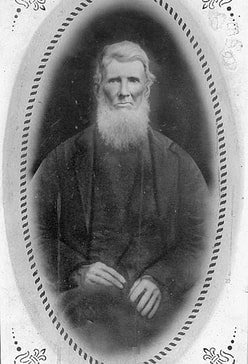September is Apple Time
 Few people would recognize the name John Chapman. Most people would recognize him by his nickname: Johnny Appleseed.
Few people would recognize the name John Chapman. Most people would recognize him by his nickname: Johnny Appleseed.Chapman was born sometime around 1774 in Leominster, Massachusetts. As a young man, he moved west, to Fort Duquesne (now Pittsburgh), Pennsylvania, where he bought a small farm and planted an orchard. A devout Swedenborgian Christian, Chapman provided free food and lodging for the pioneers who passed his farm on the was west to the Ohio Valley wilderness. As a parting gift, he pressed a small pouch into their hands before they resumed their journey.
The pouch contained apple seeds. Chapman collected the residue from local cider presses, then laboriously picked the seeds out of the sticky mash, dried them, and placed them in little deerskin bags that he had sewn. He felt that the pioneers in the wilderness needed orchards just as much as he did.
After many years, Johnny began to worry about the orchards in the wilderness. He gave his farm to a widow with a large, needy family, bought two canoes from the Natives and lashed them together, loaded them with apple seeds, then floated down the Ohio River. He traveled all over Ohio, planting new orchards and tending those that were planted before his arrival. He lived by trading seeds for food and for used clothing, and was known for wearing his one cooking pot as a hat as he walked from settlement to settlement. Native Americans regarded him as touched by the Great Spirit. Even hostile tribes left him alone. Myths began to rise up around him. One story is that, after noticing that mosquitoes flew into his fire, he doused it and said “God forbid that I should build a fire for my comfort, that should be the means of destroying any of His creatures." Another says he had a pet wolf that had started following him after he healed its injured leg. He reportedly could play with bear cubs while their mother looked on.
As settlers continued west, so did Chapman. In the 1830s he left Ohio and began planting trees in Indiana. He moved on to Wisconsin, Michigan, Iowa and Illinois. He died in 1845, his body found lying in an orchard near Fort Wayne, Indiana. In his lifetime, the botanist/herb doctor/missionary had planted thousands of trees. endeared himself to pioneer families, and become an American legend.
 These cookies are crisp on the outside and tender on the inside, just like the apples that inspired them. Before I made these, I visited my mother, picked apples from her tree, and made up several quarts of applesauce. You can use bottled sauce from the store if you're not as lucky - or industrious - as I am. Applesauce Cookies 1 cup sugar
These cookies are crisp on the outside and tender on the inside, just like the apples that inspired them. Before I made these, I visited my mother, picked apples from her tree, and made up several quarts of applesauce. You can use bottled sauce from the store if you're not as lucky - or industrious - as I am. Applesauce Cookies 1 cup sugar½ cup shortening
1 ¼ cup unsweetened applesauce
1 egg
2 ½ cups flour
1 tsp baking soda
1 tsp cinnamon
¼ tsp cloves
¼ tsp salt
1 cup raisins
½ cup chopped nuts Heat oven to 375°. Spray cookie sheets with oil.
Beat sugar and shortening until light and fluffy. Add applesauce and egg and blend well. Stir in flour, baking soda. Cinnamon, cloves and salt and mix well. Sir in raisins and nuts. Drop by rounded tablespoonfuls 2 inches apart on greased cookie sheets. Bake at 375° for 15 minutes or until light golden. Immediately move from sheet to cooling rack.
 Jennifer Bohnhoff is a retired middle school language arts and history teacher. She now writes historical and contemporary fiction from her home in the mountains of central New Mexico. You can read more about her and her books on her website.
Jennifer Bohnhoff is a retired middle school language arts and history teacher. She now writes historical and contemporary fiction from her home in the mountains of central New Mexico. You can read more about her and her books on her website.
Published on September 11, 2021 23:00
No comments have been added yet.



